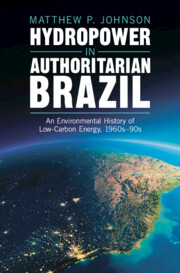Book contents
- Hydropower in Authoritarian Brazil
- Studies in Environment and History
- Hydropower in Authoritarian Brazil
- Copyright page
- Dedication
- Contents
- Figures
- Acknowledgments
- Notes on the Text
- Introduction
- 1 Setting the Scene
- 2 Building “the Big Dam”
- 3 Pharaonic Environmentalism
- 4 Negotiating with Floodwaters
- 5 Environmental Transformations
- 6 The Notorious Balbina Dam
- 7 Aftermath
- Conclusion
- Bibliography
- Index
- Series page
7 - Aftermath
The Anti-Dam Movement, Social Injustice, and Climate Change, 1990s–2010s
Published online by Cambridge University Press: 09 July 2024
- Hydropower in Authoritarian Brazil
- Studies in Environment and History
- Hydropower in Authoritarian Brazil
- Copyright page
- Dedication
- Contents
- Figures
- Acknowledgments
- Notes on the Text
- Introduction
- 1 Setting the Scene
- 2 Building “the Big Dam”
- 3 Pharaonic Environmentalism
- 4 Negotiating with Floodwaters
- 5 Environmental Transformations
- 6 The Notorious Balbina Dam
- 7 Aftermath
- Conclusion
- Bibliography
- Index
- Series page
Summary
Chapter 7 covers the changing nature of dam building in Brazil during the 1990s–2010s. It argues that during this period, mobilization for social and environmental justice among dam-affected communities began to play a greater role in the county’s dam-building program and that the movement’s priorities and achievements were not uniform. Brazil’s anti-dam movement has succeeded in modifying many new dams or blocking them outright, especially in the Amazon Rainforest, but has done little to achieve justice for the still-uncompensated Indigenous communities that were displaced by the dictatorship’s reservoirs. More than thirty years after being displaced, the Avá Guarani and the Tuxá, the Indigenous communities dispossessed by Itaipu and Itaparica, respectively, are still fighting for the land the government owes them. Climate-related challenges have been a second defining element of this period. Since the late 1990s, the Brazilian hydropower sector has endured at least three significant droughts that lowered reservoir levels, curtailing output and leading to rolling blackouts. Such episodes could become more common and severe under anthropogenic global warming. Thus, while the Brazilian hydropower sector has done much to mitigate carbon emissions, the impacts of anthropogenic warming threaten to curtail the degree to which reservoirs can produce such valuable low-carbon energy.
Keywords
- Type
- Chapter
- Information
- Hydropower in Authoritarian BrazilAn Environmental History of Low-Carbon Energy, 1960s–90s, pp. 242 - 270Publisher: Cambridge University PressPrint publication year: 2024

